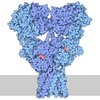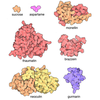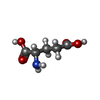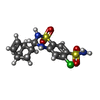[English] 日本語
 Yorodumi
Yorodumi- PDB-6o9g: Open state GluA2 in complex with STZ and blocked by AgTx-636, aft... -
+ Open data
Open data
- Basic information
Basic information
| Entry | Database: PDB / ID: 6o9g | ||||||||||||
|---|---|---|---|---|---|---|---|---|---|---|---|---|---|
| Title | Open state GluA2 in complex with STZ and blocked by AgTx-636, after micelle signal subtraction | ||||||||||||
 Components Components | Glutamate receptor 2,Voltage-dependent calcium channel gamma-2 subunit | ||||||||||||
 Keywords Keywords | TRANSPORT PROTEIN / Ion channel | ||||||||||||
| Function / homology |  Function and homology information Function and homology informationLGI-ADAM interactions / Presynaptic depolarization and calcium channel opening / eye blink reflex / positive regulation of protein localization to basolateral plasma membrane / cerebellar mossy fiber / postsynaptic neurotransmitter receptor diffusion trapping / regulation of AMPA receptor activity / channel regulator activity / Trafficking of AMPA receptors / membrane hyperpolarization ...LGI-ADAM interactions / Presynaptic depolarization and calcium channel opening / eye blink reflex / positive regulation of protein localization to basolateral plasma membrane / cerebellar mossy fiber / postsynaptic neurotransmitter receptor diffusion trapping / regulation of AMPA receptor activity / channel regulator activity / Trafficking of AMPA receptors / membrane hyperpolarization / protein targeting to membrane / voltage-gated calcium channel complex / spine synapse / dendritic spine neck / dendritic spine head / cellular response to amine stimulus / neurotransmitter receptor localization to postsynaptic specialization membrane / neuromuscular junction development / perisynaptic space / Activation of AMPA receptors / ligand-gated monoatomic cation channel activity / AMPA glutamate receptor activity / transmission of nerve impulse / response to lithium ion / Trafficking of GluR2-containing AMPA receptors / kainate selective glutamate receptor activity / cellular response to glycine / AMPA glutamate receptor complex / extracellularly glutamate-gated ion channel activity / immunoglobulin binding / asymmetric synapse / ionotropic glutamate receptor complex / conditioned place preference / regulation of receptor recycling / membrane depolarization / glutamate receptor binding / Unblocking of NMDA receptors, glutamate binding and activation / positive regulation of synaptic transmission / positive regulation of synaptic transmission, glutamatergic / regulation of synaptic transmission, glutamatergic / voltage-gated calcium channel activity / response to fungicide / cytoskeletal protein binding / glutamate-gated receptor activity / regulation of long-term synaptic depression / extracellular ligand-gated monoatomic ion channel activity / cellular response to brain-derived neurotrophic factor stimulus / glutamate-gated calcium ion channel activity / presynaptic active zone membrane / somatodendritic compartment / dendrite membrane / ionotropic glutamate receptor binding / ligand-gated monoatomic ion channel activity involved in regulation of presynaptic membrane potential / ionotropic glutamate receptor signaling pathway / dendrite cytoplasm / synaptic membrane / hippocampal mossy fiber to CA3 synapse / dendritic shaft / SNARE binding / transmitter-gated monoatomic ion channel activity involved in regulation of postsynaptic membrane potential / synaptic transmission, glutamatergic / protein tetramerization / PDZ domain binding / establishment of protein localization / response to calcium ion / postsynaptic density membrane / cerebral cortex development / modulation of chemical synaptic transmission / receptor internalization / Schaffer collateral - CA1 synapse / terminal bouton / synaptic vesicle / endocytic vesicle membrane / synaptic vesicle membrane / presynapse / signaling receptor activity / amyloid-beta binding / presynaptic membrane / growth cone / scaffold protein binding / perikaryon / chemical synaptic transmission / dendritic spine / postsynaptic membrane / neuron projection / postsynaptic density / axon / external side of plasma membrane / neuronal cell body / dendrite / synapse / protein kinase binding / protein-containing complex binding / glutamatergic synapse / cell surface / endoplasmic reticulum / protein-containing complex / identical protein binding / membrane / plasma membrane Similarity search - Function | ||||||||||||
| Biological species |   Homo sapiens (human) Homo sapiens (human) | ||||||||||||
| Method | ELECTRON MICROSCOPY / single particle reconstruction / cryo EM / Resolution: 4.8 Å | ||||||||||||
 Authors Authors | Twomey, E.C. / Yelshanskaya, M.V. / Vassilevski, A.A. / Sobolevsky, A.I. | ||||||||||||
| Funding support |  United States, 3items United States, 3items
| ||||||||||||
 Citation Citation |  Journal: Neuron / Year: 2018 Journal: Neuron / Year: 2018Title: Mechanisms of Channel Block in Calcium-Permeable AMPA Receptors. Authors: Edward C Twomey / Maria V Yelshanskaya / Alexander A Vassilevski / Alexander I Sobolevsky /   Abstract: AMPA receptors mediate fast excitatory neurotransmission and are critical for CNS development and function. Calcium-permeable subsets of AMPA receptors are strongly implicated in acute and chronic ...AMPA receptors mediate fast excitatory neurotransmission and are critical for CNS development and function. Calcium-permeable subsets of AMPA receptors are strongly implicated in acute and chronic neurological disorders. However, despite the clinical importance, the therapeutic landscape for specifically targeting them, and not the calcium-impermeable AMPA receptors, remains largely undeveloped. To address this problem, we used cryo-electron microscopy and electrophysiology to investigate the mechanisms by which small-molecule blockers selectively inhibit ion channel conductance in calcium-permeable AMPA receptors. We determined the structures of calcium-permeable GluA2 AMPA receptor complexes with the auxiliary subunit stargazin bound to channel blockers, including the orb weaver spider toxin AgTx-636, the spider toxin analog NASPM, and the adamantane derivative IEM-1460. Our structures provide insights into the architecture of the blocker binding site and the mechanism of trapping, which are critical for development of small molecules that specifically target calcium-permeable AMPA receptors. | ||||||||||||
| History |
|
- Structure visualization
Structure visualization
| Movie |
 Movie viewer Movie viewer |
|---|---|
| Structure viewer | Molecule:  Molmil Molmil Jmol/JSmol Jmol/JSmol |
- Downloads & links
Downloads & links
- Download
Download
| PDBx/mmCIF format |  6o9g.cif.gz 6o9g.cif.gz | 692.9 KB | Display |  PDBx/mmCIF format PDBx/mmCIF format |
|---|---|---|---|---|
| PDB format |  pdb6o9g.ent.gz pdb6o9g.ent.gz | 564.2 KB | Display |  PDB format PDB format |
| PDBx/mmJSON format |  6o9g.json.gz 6o9g.json.gz | Tree view |  PDBx/mmJSON format PDBx/mmJSON format | |
| Others |  Other downloads Other downloads |
-Validation report
| Summary document |  6o9g_validation.pdf.gz 6o9g_validation.pdf.gz | 1.1 MB | Display |  wwPDB validaton report wwPDB validaton report |
|---|---|---|---|---|
| Full document |  6o9g_full_validation.pdf.gz 6o9g_full_validation.pdf.gz | 1.2 MB | Display | |
| Data in XML |  6o9g_validation.xml.gz 6o9g_validation.xml.gz | 104.4 KB | Display | |
| Data in CIF |  6o9g_validation.cif.gz 6o9g_validation.cif.gz | 156 KB | Display | |
| Arichive directory |  https://data.pdbj.org/pub/pdb/validation_reports/o9/6o9g https://data.pdbj.org/pub/pdb/validation_reports/o9/6o9g ftp://data.pdbj.org/pub/pdb/validation_reports/o9/6o9g ftp://data.pdbj.org/pub/pdb/validation_reports/o9/6o9g | HTTPS FTP |
-Related structure data
| Related structure data | 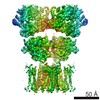 7962MC  7959C  7960C  7961C 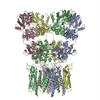 6dlzC  6dm0C  6dm1C M: map data used to model this data C: citing same article ( |
|---|---|
| Similar structure data |
- Links
Links
- Assembly
Assembly
| Deposited unit | 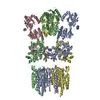
|
|---|---|
| 1 |
|
- Components
Components
| #1: Protein | Mass: 115178.531 Da / Num. of mol.: 4 Source method: isolated from a genetically manipulated source Source: (gene. exp.)   Homo sapiens (human) Homo sapiens (human)Gene: Gria2, Glur2, CACNG2 / Production host:  Homo sapiens (human) / References: UniProt: P19491, UniProt: Q9Y698 Homo sapiens (human) / References: UniProt: P19491, UniProt: Q9Y698#2: Chemical | ChemComp-GLU / #3: Chemical | ChemComp-CYZ / #4: Chemical | ChemComp-LU7 / | Has protein modification | Y | |
|---|
-Experimental details
-Experiment
| Experiment | Method: ELECTRON MICROSCOPY |
|---|---|
| EM experiment | Aggregation state: PARTICLE / 3D reconstruction method: single particle reconstruction |
- Sample preparation
Sample preparation
| Component | Name: GLuA2-STZ complex in activated state blocked by AgTx-636 Type: COMPLEX / Entity ID: #1 / Source: MULTIPLE SOURCES |
|---|---|
| Source (natural) | Organism:  |
| Source (recombinant) | Organism:  Homo sapiens (human) / Cell: HEK293 gnti- Homo sapiens (human) / Cell: HEK293 gnti- |
| Buffer solution | pH: 8 |
| Specimen | Embedding applied: NO / Shadowing applied: NO / Staining applied: NO / Vitrification applied: YES |
| Vitrification | Cryogen name: ETHANE |
- Electron microscopy imaging
Electron microscopy imaging
| Experimental equipment |  Model: Titan Krios / Image courtesy: FEI Company |
|---|---|
| Microscopy | Model: FEI TITAN KRIOS |
| Electron gun | Electron source:  FIELD EMISSION GUN / Accelerating voltage: 300 kV / Illumination mode: FLOOD BEAM FIELD EMISSION GUN / Accelerating voltage: 300 kV / Illumination mode: FLOOD BEAM |
| Electron lens | Mode: BRIGHT FIELD |
| Image recording | Electron dose: 55 e/Å2 / Film or detector model: GATAN K2 SUMMIT (4k x 4k) |
- Processing
Processing
| CTF correction | Type: PHASE FLIPPING ONLY |
|---|---|
| 3D reconstruction | Resolution: 4.8 Å / Resolution method: FSC 0.143 CUT-OFF / Num. of particles: 31129 / Symmetry type: POINT |
 Movie
Movie Controller
Controller


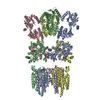
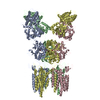
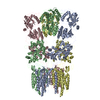

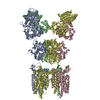
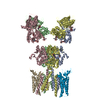
 PDBj
PDBj